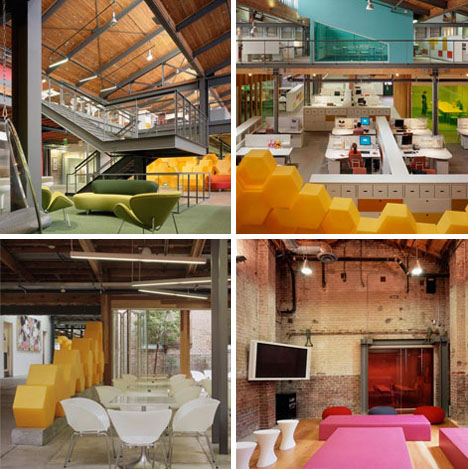
These ideas resonate today, but now some purchasers favor to place walled, enclosed places of work or convention rooms towards the building core and open-plan workstations towards the perimeter, with plenty of window area. Building Teams are extending this approach, which many see as extra egalitarian, by making certain that communal areas also have entry to daylight and views. To accommodate extra individuals with fewer desks, designers are turning to strategies corresponding to desk sharing, free desking, benching, and hoteling. Unassigned touch-down spaces, which can be open or enclosed, provide a modicum of visual and acoustical privateness and the power to support individual work or one-on-one meetings. “Furniture may be either informal lounge seating with an integrated work surface, or a desk with two chairs,” says LPA’s Thomas.
It’s the central a part of our day and often the place we spend essentially the most time in. This is why, in addition to functioning well, we want an workplace design that creates a pleasant and welcoming place to spend time in. Workers themselves have been the primary to tackle this problem. Just as IT has been consumerized over the past decade, digital-savvy employees are starting to demand that their areas adapt to how they work, quite than vice versa. This shift started in earnest in 2005, in San Francisco, London, and Berlin. Technologists, programmers, and inventive professionals needed to work exterior confining office environments but in addition to avoid the isolation of house workplaces. They chose to work aspect by facet, in what are known as coworking areas.

Why Is My Workplace So Chilly? Exploring The Missed Aspects That Contribute To Workplace Wellbeing
However, research has proven that walking round through the day is essential to workers’ physical and emotional health. CBRE’s Los Angeles office was designed with a flight of stairs directing foot traffic via the main collaborative area. “We do this to challenge convenience just sufficient to get our employees shifting, collaborating, and taking the steps, rather than the elevator,” says Beaudoin. One benefit afforded by widespread zones is that coworkers can collect for group meetings and never worry about reserving a conference room. Building Teams should make sure the inevitable noise doesn’t interfere with areas set aside for performing quiet focus work.
Office Design Tendencies For Reinforcing Worker Engagement
Our mission is to assist people visualize, create & keep beautiful properties. We convey to you inspiring visuals of cool properties, particular spaces, architectural marvels and new design tendencies. Believe it or not, the average adult spends over 50% of their daytime hours in an office.
Residence Workplace For Two
“Ideally, these spaces could be geared up with writable wall surfaces and entry to sunlight.” A wall-mounted flat-display screen monitor is an optional but nice-to-have factor. “Personal workspaces are getting smaller, as a result of the technology we’re using is smaller,” says JZA+D’s Zucosky. “Flat-display screen displays allow shallower work surfaces, which implies much less footprint per workstation.” She provides that providing area for doc piling is much less essential right now, with most documents residing on computers. Rachel Casanova, LEED AP ID+C, an Associate Principal and Director of Workplace Strategy with Perkins+Will New York (), says individual desk size is lowering in width, to round 5 linear feet. “This might be the smallest we can get, however now we have to give attention to how we are able to make office areas more effective,” she says.
Modularity applies to the planning process as nicely, says HOK’s Sannella. By making private workplaces and convention rooms the same measurement, it is a lot simpler to repurpose area by shifting furnishings, versus flattening partitions. Small places of work could be planned as 10×10-foot modules; two modules may be mixed to create a 10×20-foot office. Another option is to make use of a demountable partition or folding wall to quickly break up one massive office into two small ones. The open workplace structure continues to be valued, in part, for its authentic advantages. In late 19th- and early twentieth-century industrial buildings with out modern lighting and air-conditioning, central bullpens helped channel contemporary air and daylight deep into the floorplate.
